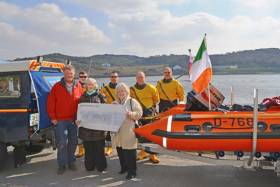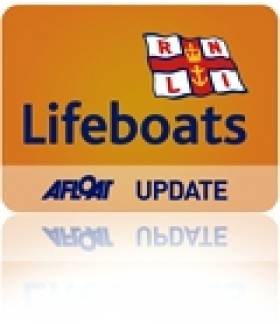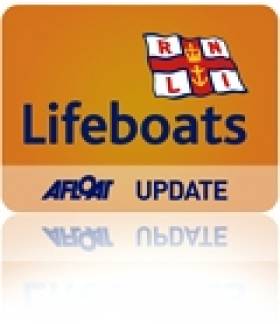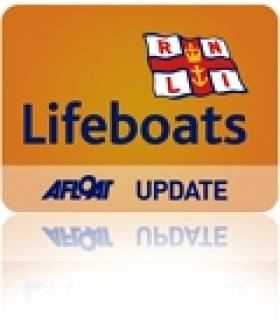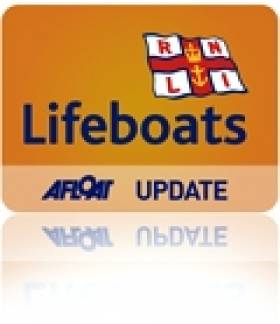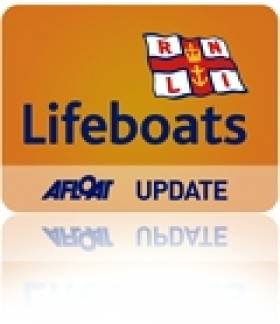Displaying items by tag: Clifden
Sun Shines On St Patrick's Day Donation To Clifden Lifeboat
#RNLI - Bright sunshine and a much appreciated donation was a great start to St Patrick’s Day for the crew of Clifden RNLI.
Longtime supporters and fundraisers Jacqueline Hannon and Nancy Duffy of Claddaghduff, Co Galway presented a cheque for €1,820 to the Clifden volunteer lifeboat crew, the proceeds of a Christmas concert and fundraising event held in Joyce’s Bar in the fishing village of Cleggan on 16 December.
John Brittain, Clifden RNLI Lifeboat Operations Manager said: "We are really delighted to welcome Jacqueline and Nancy to Clifden station once again and would like to thank them most sincerely for the hard work and organisation of this fantastic fundraiser.
"Special thanks also to the people of Cleggan and Claddaghduff who generously supported the event."
After the cheque presentation, the volunteer crew participated in both the Clifden and Roundstone annual St Patrick’s Day parades.
Clifden Lifeboat Rescues Dog Walker After Van Stranded By Tide
#RNLI - Clifden RNLI's inshore lifeboat Granuaile launched yesterday afternoon (Saturday 9 January) to assist a walker and her six dogs who had been stranded on Omey Island on the Connemara coast by the rapidly incoming tide.
The popular walking destination is widely accessible by car and on foot at low tide, but the speed of the incoming tide is notoriously deceptive and strandings of this kind are not uncommon in the area.
Clifden RNLI helm Joe Acton, who recently received an award of long service for 20 years as a volunteer, said: "When we arrived on the scene, the lady and her six dogs had already abandoned her van and made their way back to the shore. We were more than happy to return them all safely to the shore."
Also on the callout were Clifden RNLI volunteers Alvin Bell, David O'Reilly, shore crew Ian Shanahan and driver Neil Gallery.
Second Island Evacuation In Fortnight For Clifden RNLI
#RNLI - Clifden RNLI's all-weather lifeboat Pride and Spirit was launched shortly after 4pm on Tuesday (24 November) to undertake an urgent medical evacuation from the island of Inishturk North.
This was the second such callout in a fortnight, after a medevac from Inishbofin on 15 November, with severe weather conditions once again facing the volunteer crew, who have had a busy year to date trialling the Mersey-class lifeboat.
With winds blowing north-west Force 7 to 8 and a swell warning issued by Met Éireann, a round trip of almost 50 nautical miles was required to bring the casualty to shore for urgent medical attention.
"The swell was over five metres at times and it took us around an hour and 45 minutes to reach the island," said Clifden RNLI coxswain John Mullen, "but thankfully the Pride and Spirit is well equipped for such conditions.
"We brought the casualty into Cleggan Harbour shortly after 7pm and would like to wish her a speedy recovery."
The volunteer lifeboat crew consisting of Owen Hayes (navigator), Robert King (mechanic), David O Reilly, Daniel Whelan and coxswain Mullen returned to Clifden Bay shortly before 9pm.
Early Morning Island Medevac by Clifden Lifeboat
#RNLI - The crew of Clifden RNLI had an early start in dark and dangerous conditions yesterday morning (Sunday 15 November) when an emergency medical evacuation was required from Inishbofin.
After a 5.43am pager alert, the volunteer lifeboat crew consisting of Alan Pryce, Robert King, David Barry, Daniel Whelan, Brian Ward and David Coyne set out for the island in the all-weather lifeboat Pride & Spirit.
Clifden RNLI deputy launching authority Saul Joyce described the conditions at the time as "extremely challenging and certainly the most severe weather the crew have experienced in the all-weather Mersey class lifeboat to date."
On arriving at Inishbofin Harbour, the crew met with the district nurse who helped transfer the casualty onto the waiting lifeboat. The patient, a woman experiencing severe abdominal pain, was then taken by lifeboat to Cleggan where an ambulance was waiting.
Clifden RNLI coxswain Alan Pryce said of the launch: "With winds consistently Force 8 and above at times and a heavy five- to six-metre swell, this proved a challenging call for our crew, particularly setting off in darkness. We wish the patient a speedy recovery."
Clifden Lifeboats Launch To Injured Angler
#RNLI - Clifden RNLI launched to an emergency medical situation at 12.50pm yesterday (Thursday 17 September) in Clifden Bay.
A male angler had become unwell and as a result sustained a head injury, leaving him in need of urgent assistance.
The Irish Coast Guard requested the immediate launch of both Clifden RNLI’s Atlantic 85 and all-weather lifeboats.
Clifden RNLI volunteer crew members Kenneth Flaherty and Barry Ward boarded the angling boat and administered first aid to the casualty. Oxygen was administered and the casualty was placed in the recovery position.
Lifeboat helm Thomas Davis then requested two more crew members from the all-weather lifeboat, which was standing nearby, to assist in the transfer of the casualty to a stretcher.
Speaking after the callout, Clifden RNLI helm Thomas Davis said: "The lifeboat crew responded quickly and calmly to this situation, in which the casualty was seriously unwell.
"Having the additional crew members nearby in the second lifeboat was vital and the total time between the pagers going off and recovery to shore was around 38 minutes."
The casualty and another angler were transferred to shore where an ambulance was waiting. At this point the coastguard helicopter Rescue 118 had also landed and with the assistance of Cleggan Coast Guard, he was transferred to University College Hospital Galway.
Clifden RNLI lifeboat operations manager John Brittain added: "Well done to the Clifden volunteer crew members for a seamless rescue and for once again working well in conjunction with the coastguard and other emergency services."
#RNLI - Clifden RNLI carried out its first medical evacuation off Inishbofin island today (Thursday 21 May).
In what was the fourth callout this week for the station, the volunteer lifeboat crew was paged shortly after 11.30am following a report that a casualty required assistance.
The inshore Atlantic 85 lifeboat helmed by Bernard Whelan and the all-weather Mersey class lifeboat under coxswain John Mullan launched immediately and made their way to the scene. The Irish Coast Guard helicopter Rescue 115 from Shannon was also tasked.
Weather conditions at the time were foggy and visibility was poor. There was a Force 4-5 south westerly wind and a heavy swell.
The Atlantic 85 with crew members James Mullan, Daniel Whelan and Dermot Clancy onboard arrived on scene first. Mullan, a first aider with Clifden RNLI, went ashore and assisted the island nurse who was attending to the casualty.
When the all-weather lifeboat arrived at 1pm, the casualty was transferred to this lifeboat and brought to the mainland at Cleggan Pier where there was an ambulance waiting.
Speaking following the callout, Mullan said: "We have assisted with many medical evacuations in the past but today was the first time that our crew transported someone from Inishbofin island and brought them safely to the mainland.
"Both lifeboat crews worked well together today and we were happy to assist the island nurse in bringing this person to safety."
This was the fourth callout for Clifden RNLI this week. The crew assisted with two other medical evacuations and also went to the assistance of a yacht which got into difficulty on the shore.
Galway Lifeboat Rescues Woman Swept Out To Sea
#RNLI - A woman was recovering in hospital in Galway last night (Wednesday 6 May) after being rescued by Galway RNLI lifeboat.
The alarm was raised by members of the public who spotted the woman in the River Corrib being swept out to sea.
They alerted the emergency services and a 'blanket' callout was made to the lifeboat, Garda, Irish Coast Guard, Galway Fire Brigade and the ambulance service at around 11.41pm.
Galway RNLI launched within minutes with helm Shane Folan and crew Dan King, Emma Hennessy and David Badger, and the woman was quickly located near waters at the Galway Enterprise Park at Galway Docks.
She was taken on board the lifeboat and brought ashore where she was transferred to a waiting ambulance and taken to University Hosptial Galway.
Galway RNLI shore crewmember John Byrne said: "The new emergency service plan for river rescues worked very well with all rescue services on the scene very quickly."
The rescue came a day after Clifden RNLI aided two lobster fishermen yesterday after their boat got into difficulty on the Connemara coastline.
At approximately 10.30am on Tuesday 5 May, Clifden RNLI's volunteer lifeboat crew was requested to launch by the Irish Coast Guard and go to the aid of two lobster fishermen in difficulty off the Aughrus peninsula.
Having experienced engine failure, the boat was drifting dangerously close to the rocks when its crew raised the alarm.
The Atlantic 85 inshore lifeboat Benjamin Downing Fairbridge was launched and was on the scene within 10 minutes of leaving shore.
Lifeboat helm Bernard Whelan and volunteer crew members Kenneth Flaherty, Joe Acton and Owen Hayes then towed the two fishermen in their boat back to Rossadillisk pier in Cleggan.
Speaking following the callout, Clifden RNLI lifeboat press officer Catherine Pryce said: "The crew responded rapidly and were delighted to be able to assist the fishermen."
Three Callouts In Four Days For Clifden Lifeboats
#RNLI - Volunteer crew members at Clifden RNLI in Co Galway responded to three callouts in four days at the weekend.
The busy period from Friday 17 to Monday 20 April involved the crew responding to three incidents including a medical evacuation off Inishbofin, a launch to assist three people in difficulty off Inishlacken Island, and a search involving all three of Clifden’s lifeboats for two missing kayakers near Ballyconneely.
The crew was first paged at 4.41pm on Friday following a request to carry out a medical evacuation on Inishbofin.
Clifden RNLI’s Atlantic 85 inshore and all-weather Mersey class lifeboats were launched to the scene along with the Irish Coast Guard’s Rescue 118 helicopter from Sligo.
The inshore lifeboat with three crew members was dispatched first to assist the island nurse if required. The all-weather lifeboat followed as back-up.
Once on scene, the crew observed that the casualty had been taken care of and was medically evacuated from the island by the helicopter.
On Sunday night, the pagers sounded again shortly after 9pm, as the coastguard requested a launch following a report from a member of the public that three people were in difficulty in the water off Inishlacken Island.
The D class lifeboat was taken by Land Rover and launched from Roundstone while the all-weather lifeboat was put to sea from Clifden.
Three people had been watching a basking shark when their dinghy was overturned by a breaking wave. They had successfully managed to swim to the shore when they were spotted by the coastguard helicopter and were found to be safe and well when located by the lifeboat crew.
The final callout came on Monday at 10.20pm and required the involvement of all three of Clifden’s lifeboats.
Both the inshore B and D class lifeboats and the all-weather Mersey class lifeboat were launched at the request of the coastguard following a report that two kayakers were seen leaving a beach near Ballyconneely but had not returned.
The alarm was raised by a member of the public who spotted two people leave Aillebrack beach and put to sea at approximately 2pm that afternoon. However, when darkness fell and with the cars still on the beach, the caller became concerned.
All three RNLI lifeboats from Clifden were launched along with Rescue 118 and the Cleggan Coast Guard Unit. Clifden RNLI’s all-weather lifeboat was appointed on scene commander and began a search offshore while the B and D class lifeboats searched inshore near Slyne Head.
RNLI crew members who were assisting in the search from the shore located the two casualties safe and well at Dunloughan Beach.
Speaking following the busy period for the station, Clifden lifeboat operations manager John Brittain said: "Firstly, I would like to thank the members of the public who raised the alarm on two occasions here as their vigilance was very important in leading to successful outcomes.
"I would also like to thank our own volunteers who despite a busy weekend, responded promptly and professionally throughout.
"We would encourage anyone taking to the water to enjoy themselves but be mindful of the importance of informing the coastguard of their planned passage and destination, and the expected time of their return."
#RNLI - The Clifden RNLI volunteer lifeboat crew scrambled into their kit for a special callout recently when they provided a guard of honour for their two fellow lifeboat crew Alan Pryce and Sinéad O’Sullivan, who tied the knot in St Joseph’s Church recently.
The couple met through their life saving work volunteering as crew with Clifden RNLI.
And lifeboats played a big part in their day, from the RNLI guard of honour, to the special stop at the station for a photograph with their beloved lifeboat, to a wedding cake which featured the couple dressed in their full RNLI kit.
O’Sullivan joined Clifden RNLI eight years ago and is the station’s only female crewmember. A trained lifeguard, she is currently training to be a helm on the station’s D-class inshore lifeboat and a navigator on the all weather lifeboat.
For her day job, O’Sullivan is an estate agent and auctioneer and is well known all over Connemara for her enthusiasm and energy and getting involved in many good causes.
Her groom is a fellow Clifden native who signed up as volunteer RNLI lifeboat crew at just 17 years of age, through his interest in fishing and sailing.
Since then Pryce has become helm on the D-class and Atlantic-class inshore lifeboats and is one of the station’s four coxswains on the all-weather lifeboat, which is currently on a two-year trial at the station.
"Being in the RNLI is a huge part of both of our lives so we were really delighted that we were able to incorporate it into our wedding celebrations," said Pryce.
"We both love the sea and share a passion for all water based activities, so it was definitely one of our shared interests that resulted in us getting together."
O’Sullivan added: "We were really thrilled that we could share our wedding with two of our favourite things - the Clifden lifeboat and our beloved dog Pippa."
After the wedding, the couple enjoyed a quick mini-moon to Wicklow where they even stopped in briefly to Arklow RNLI to admire their Trent all-weather lifeboat.
And now that the dust has settled and all the party clothes are put away, the newlyweds are back on service and ready to answer the call of the RNLI pagers.
Clifden Lifeboat Tows Fishing Vessel To Safety Off Connemara
#RNLI - Clifden RNLI's all-weather lifeboat was launched on Friday last (20 February) to go to the aid of a fishing boat in difficulty off the Connemara coast.
The alarm was raised around 11.30am when the 35ft fishing vessel reported engine failure.
The boat was located between Inishbofin island and Cleggan Head, having departed Derryinver that morning with two crew on board.
Weather conditions were worsening at the time of departure, with a westerly Force 6 blowing as the Mersey class Pride and Spirit all-weather lifeboat was launched.
The boat and its crew were towed back to Derryinver pier where they expressed their thanks for the assistance provided.
Speaking following the callout, Clifden RNLI coxswain James Mullen said: "Considering that this is only the third launch for the Pride and Spirit since she has been on service in Clifden, the crew did extremely well to carry off a smooth and efficient launch, rescue and recovery.
"And of course we are always glad to be able to help any boat in difficulty in our area of operation."


























